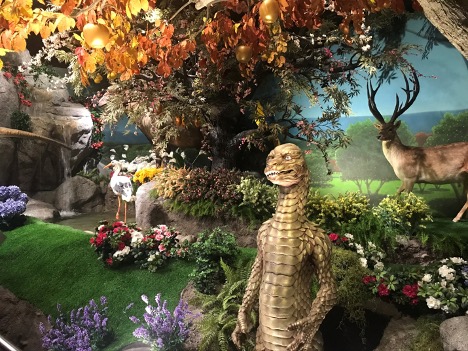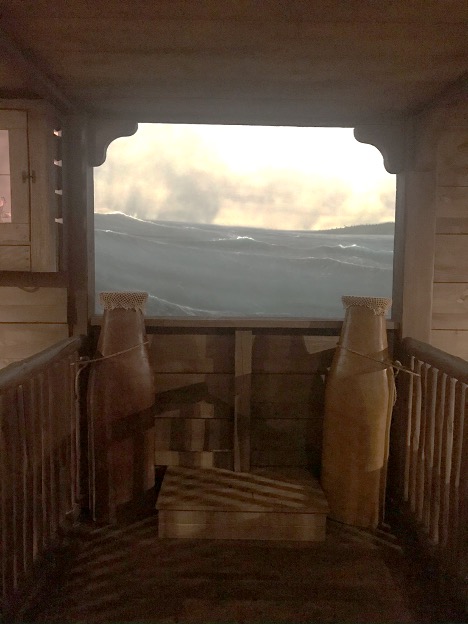by Emma Frances Bloomfield
Today’s post comes from our colleague Emma Frances Bloomfield, Associate Professor of Communication Studies at the University of Nevada, Las Vegas, who studies the intersection of science, religion, and politics from a rhetorical perspective. She received her PhD from USC Annenberg and wrote her dissertation on the similarities between science denial in the human origins and climate change controversies. She has written and presented on topics of the environment, digital rhetoric, narratives, political communication, and health. Her first book, Communication Strategies for Engaging Climate Skeptics: Religion and the Environment, is available through Routledge’s series on Advances in Climate Change Research. Her second book, Science v. Story: Narrative Strategies for Science Communicators, is forthcoming in spring 2024 from University of California Press.
In January 2020, only a few months before the world shut down due to the COVID-19 pandemic, I visited the Discovery Center for Creation and Earth History run by the Institute for Creation Research in Dallas, Texas. Opened in September 2019, the Discovery Center is an impressive space that uses advanced technology and a series of engaging exhibits to communicate what ICR purports to be the truth of creation science.

I analyzed the space in a recently published article titled, “Sensory Engagement with the Rhetoric of Science: Creationist Copia at the Discovery Center for Science and Earth History” (Rhetoric & Public Affairs, vol. 25, issue 4, 2022). In the article, I argue that the Discovery Center uses sensory evidence to control and guide museumgoers’ attention and distract from a lack of traditional evidence, such as fossil records, experiments, or expert testimony. I draw upon the concept of copia (meaning abundance) to inform my analysis, which is a rhetorical trope that substitutes quantity over quality and creates a sense of intensity and importance around a topic as evidence for it. Take, for example, the communication strategy of Duane Gish, former ICR vice president, who is the eponym for the “Gish Gallop,” which is where creationists rattle off a series of “half-truth non-sequiturs” that are difficult for audiences to comprehend and evolutionary scientists to refute but appear impressive due to their quantity and succession (Eugenie Scott, 1994).
At the Discovery Center, I located copia in terms of intensity and quantity of sensory evidence. I categorize these sensory strategies as rotation, immersion, and interruption. Rotation arises when museumgoers are encouraged to turn from one piece of information to another. Immersion occurs when visitors are surrounded by various pieces of sensory information at the same time. Interruption is deployed when the museum space is punctured by noises or presences that draw attention away from some areas and redirect it to others. All three direct and redirect museumgoers’ attention to focus on certain noises, sights, and experiences over others. As forms of copia, these strategies work to amplify creationism’s importance and create an abundance of evidence to give weight to creationism in the manufactured controversy over human origins. While the full article has many more examples, I will briefly discuss one example of each of the three sensory strategies.
Rotation
One of the first rooms in the Discovery Center is the “portrait room,” where what first appear to be static portraits of scientists lining the walls. These portraits are in fact screens, which come to life to engage in a lively conversation about the role of faith in scientific discovery. As the conversation bounces from portrait to portrait, visitors spin to follow the conversation happening around them, rotating to follow the next screen that lights up and begins talking. The portraits speak quickly, one right after the other, so following the complete flow of the conversation is near impossible as visitors must quickly reorient and rotate to a new screen, potentially behind them. Just as in a face-to-face interaction, the portraits interrupt one another and have no preset order, forcing visitors to rotate quickly to keep up, and they may miss some of the key points during one’s reorientation to the newly active portrait. Visitors can thus be easily overwhelmed with conversation and unable to critically follow the arguments and discussion.


Immersion
Immersion primarily occurs in the Garden of Eden and Noah’s Ark rooms. Both rooms consist of full-scale dioramas that visitors can walk through and thereby find themselves within that part of biblical history. In the Garden of Eden room, visitors navigate a jungle landscape with storks, deer, parrots, monkeys, and velociraptors. They hear the roaring of a waterfall, the coos of birds, and the groans of dinosaurs. In the Noah’s Ark room, museumgoers can similarly hear the noises of animals and the crashing of thunder as they walk through pens filled with animatronic animals. Visually, visitors can look out the ship’s window with flashing lights to mimic lightning and the walls painted to look like a turbulent sea. As immersive dioramas, visitors are invited to turn to explore the variety of animatronic animals and noises that emerge from all sides. Instead of scientific evidence of creationism, the Discovery Center creates immersive experiences to simulate the accuracy and presence of biblical history, locating museumgoers in the center of engaging dioramas.




Interruption
After Noah’s Ark room is the Animal room, which is lined on one side by a beautiful façade of the Grand Canyon. Distracted by the large and deep diorama, visitors are startled by a roar vocalized by a life-sized animatronic Tyrannosaurs Rex stationed in the center of the Animal Room. The roar of the dinosaur interrupts museumgoers’ exploration of the Grand Canyon exhibit and its informational posters to redirect attention to the large animatronic figure. Although not a true threat, the unexpected roar from the animatronic dinosaur can surprise visitors and immediately hails their attention away from the Grand Canyon to be co-present with a T-Rex. As visitors explore the Animal Room and (attempt) to read the many interactive screens, the timed roar of the T-Rex is a constant distraction.


My experience at the Discovery Center was an interesting one. I saw many similarities to Ark Encounter, which I previously published about in the Southern Communication Journal and wrote about on this blog, but many differences as well. What struck me at the Discovery Center was the near complete reliance on museumgoers’ sensory experiences as the primary evidence for the truth of creationism. Museumgoers are encouraged to agree with ICR that creationism deserves space in contemporary scientific discussions due to the copia of evidence in terms of intensity and salience and the quantity of sensory information, which is deployed to rotate, immerse, and interrupt museumgoers’ experiences of the space.
I do not intend for this work (or any of my work) to disparage religious ways of knowing or the senses as sense-making tools. Instead, I propose that copia can be used verbally but also in sensory arguments at creationist sites to maintain the controversy over human origins. Thus, I consider it important to attend to the senses as powerful rhetorical strategies that may be leveraged as a tool to disrupt public understanding of and engagement with science.

So it’s nothing more than a faculty created by the ICR to torture people’s minds in every mental and psychological way into agreeing with them in all of what they say about their young earth fantasies while making them forget about the complete lack of any physical evidence for young earth creation.
Definitely NOT for Autistic people!
Hi Sherry, Thanks for engaging in my post! Yes, I argue that the sensory elements are forms of argumentation that work to distract from more “typical” and empirical scientific arguments that work from data and evidence. I hadn’t considered the potential for these strategies to affect autistic people and children – it’s a great point! I know many museums now have sensory-friendly days, but I imagine that might be hard for the Discovery Center to manage as many of the exhibits would have to be altered quite a bit.
The same reason Ken Ham’s The Ark Encounter and the Creation Museum were built for: to mess around with people’s minds in hopes of torturing and manipulating them into agreeing with everything Ham says and conform to his fantasy “worldview” while forgetting, denying, and ignoring the physical evidence confirming the world and the Bible to be everything BUT what Ham thinks it is.
Good, provocative account. We need to be well aware of our opponents’ impressive rhetorical skills. This summary led me to the full article, unfortunately paywalled, but I have institutional access. I think it would be very useful for a scientist or historian of science to visit the museum, and report on content. if I still lived near Dallas, I would do it myself.
The ice age room is particularly interesting. Ken Wolgemuth (email) describes it as “Right in the middle was an “Ice Age” room very well air conditioned, and walls and ceiling were photos of ice, and using dim blue lighting. A video played for the victims to watch. It was a 700 year ice age after Noah’s Flood 4,400 years ago. And one of the video speakers was a PhD in geology!!”
I have discussed creationist ice age pseudoscience here: https://rightingamerica.net/creationism-and-climate-the-birth-of-a-new-pseudo-science/ and I regard it as particularly important because of the links between climate pseudoscience, climate crisis denial, the main creationist institutes, the Cornwall Alliance (which others have discussed here), and hence with Heartland Foundation, the Heritage Institute, the fossil fuel companies, and the centres of US conservative thought.
By describing Henry Morris as the “founder of creation science”, the museum reaches new levels of effrontery and mendacity. Morris took his core ideas direct from George McCready Price, although The Genesis Flood only acknowledges Price in connection with geological faults. Price and other precursors are of course discussed in scholarly detail in Ronald Numbers’ The Creationists, and I cannot believe that they creators of this museum were unaware of all this.
Hi Paul, Thanks for engaging with with my post and the full article! I’ve visited a few creation museums and each time I bring my husband (also named Paul!) who is an astrophysicist. It’s great to hear his perspective on the exhibits as well, but perhaps he needs to publish a separate account!
I found the ice age room at the Discovery Center quite different from others I had visited. While they all have them and typically stylize them with white walls and cool lighting, this was the first I visited that manipulated the temperature, which I found very interesting. I am also very familiar with the groups you mentioned and the overlaps between creationism and climate denial (this was the topic of my dissertation). I look forward to reading more of your work in this important area!
“perhaps he needs to publish a separate account! ” Indeed, that would be most welcome
And thanks for your encouraging words about my own work
Thanks so much for this article, Emma. I have started working on a paper that compares a 47-page creationist paper on the Coconino Sandstone in Arizona by Whitmore and Garner to a 11-page conventional geology paper on the coeval Glorieta Sandstone in New Mexico by Mack and Bauer. In my conclusion, my current draft states: “From the process-response model point of view used in modern geologic research papers, we find that in the final analysis, we are able to learn more about the Glorieta Sandstone (as well as some important details about the Coconino) from the 11-page paper by Mack and Bauer than we can about the Coconino Sandstone from the 47-page paper from Whitmore and Garner.” When I saw your article, I suddenly realized that Copia is possibly the main technique being used by Whitmore and Garner, as they load up their paper with all kinds of photographs and charts, almost as if they want to impress the reader into thinking they’re doing real science. I would like very much to get my hands on your paper in Rhetoric & Public Affairs (Vol. 25, issue 4, 2022) — I’ll buy it if I have to!